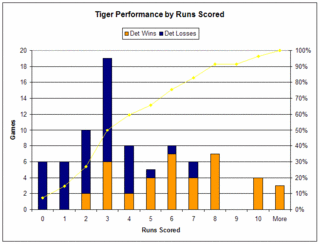Typically when I do one of these post, its out of laziness. This time, there are a lot of things I want to cover – briefly.
Matt Roney leaves
While this actually happened a week ago, I just never had a chance to comment. Matt Roney, as those of you who survived the 2003 season remember, was a Tigers Rule 5 pick. He had mixed results out of the bullpen for the Tigers that season. Last year he went to AA Erie and worked as a starter posting an unremarkable 4.93 ERA and 6.01 K/9.
This year Roney moved to relief and split time at Erie and AAA Toledo. Betweent he two clubs he struck out 50 and walked 17 in 50 innings. He also allowed only one home run.
Roney had a clause that if he wasn’t on the 40 man roster by July 1st he could request his release, and he excercised that right. Why is this an issue? Matt Roney is only 25 and was striking out a batter an inning. Meanwhile he was blocked on the roster by Mark Woodyard and Doug Creek. Now Woodyard has been doing okay for Toledo, and is 26. Doug Creek has been struggling for the Tigers (6 homers in 15 innings) and is 36. For a team trying to build and maintain young depth allowing Matt Roney to walk made little sense.
Wish List
Beyond the Boxscores recently posted a team of All Time All Stars he’d like to see take the field. It’s a pretty interesting concept and Brian’s list is pretty thorough.
Lou Whitaker and his game breaking speed
One of the things that Lou Whitaker didn’t possess that any HoF second basemen have is a high stolen base total. However, in the midst of a recent study by Tom Ruane (found via Studes at Hardball Times) there was a piece on the value of stolen bases. Specifically he looked at the context of each stolen base and found out which were the most important.
Lo and behold that Whitaker showed up 7th on the list of players who’s stolen base value was higher than their raw totals would indicate. Now I just need to find the address of the Veteran’s Committe to get this information to them.
Dmitri’s Struggles
I know that many of you want to see Dmitri Young traded. I also know that this is driven partly by Chris Shelton’s emergence, but also in large part due to Young’s struggles his year. However, Dmitri Young will be extremely hard to move because he has an option that is most likely to vest, and he’s been struggling. So Young will be here for awhile.
Fortunately he’s hit the ball pretty hard the last couple games. And actually, until his recent spiral downwards he had been hitting the ball pretty hard – just without the results. He’s 36th in the AL in line drive percentage which means he’s still hitting the ball hard. Thirty-sixth isn’t a reason to get excited, but it should probably indicate a better line than 244/307/461.
So don’t worry, Young will get better – but he isn’t going anywhere.
Audioblogging
I will give the audioblogging thing a shot. Unfortunately I don’t really have any ability to control appearance, or add titles, or basically anything else. So check back during the Futures Game and Legends game for audio updates. I’m not sure how they’ll turn out, what with blogging from a stadium full of ambient noise, but we’ll see.
Fanfest
I took the family to FanFest yesterday and I was very impressed. You could easily spend 3-4 hours there, and there is something for all ages. I was particularly impressed with the volunteer staff. There were very friendly orange-shirted staff everywhere who were great ambassadors for visitors to Detroit.

